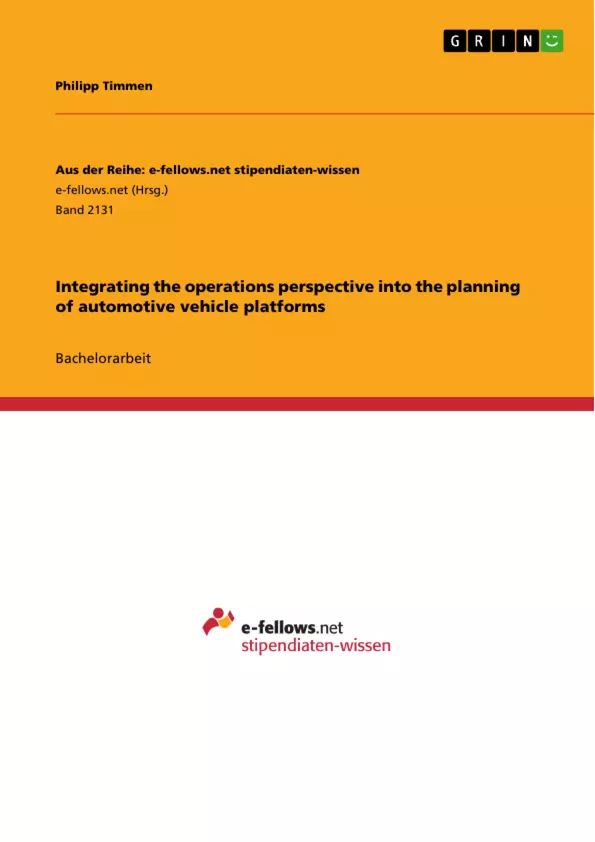In order to react on a broader product portfolio and shortened product life cycles, the usage of platform concepts gains an increasing importance for automotive OEMs to establish cost and time savings. However, current industry best practices and existing literature do not integrate the operations perspective into the planning of automotive platforms to a sufficient extent. Therefore, this thesis discusses:
I. the role of the strategic operations planning for platform planning.
II. This results in a mixed-integer linear programming approach, integrating the operations perspective into the planning of automotive vehicle platforms. The overall objective is to allocate existing vehicles to an existing set of platform concepts, while minimizing associated cost.
III. Based on a numerical case study the use of the newly established model is compared with an incremental platform planning approach.
IV. Finally, the benefit of the model is evaluated before the integration of further potential operations aspects gets discussed.
Inhaltsverzeichnis
- Abstract
- Table of Contents
- List of Figures
- List of Tables
- List of Abbreviations
- List of Symbols
- 1 Introduction
- Automotive planning processes
- Product development process
- Description of a product development process
- Importance of the product development process
- Planning horizons
- Reference planning landscape for automotive OEMs
- Role of platform strategies in automotive planning
- Platform definitions and example
- Benefits of platform strategies
- Platform decisions and implications
- Strategic operations planning tasks
- 2 Integration challenges and requirements
- Literature review
- Research gap
- 3 Reference MILP model
- Problem setting
- Objective function
- Constraints
- 4 Numerical study
- Data set
- Single-stage optimization
- Two-stage incremental optimization
- Comparison
- 5 Conclusion
- Summary
- Outlook and recommendations
- Reference List
- Appendices
- Analyse der aktuellen Praxis und Literatur zur Plattformplanung im Automobilsektor
- Identifizierung der Herausforderungen und Anforderungen bei der Integration der operativen Perspektive
- Entwicklung eines Mixed-Integer Linear Programming (MILP)-Modells zur Integration der operativen Perspektive in die Plattformplanung
- Bewertung des Modells durch eine numerische Fallstudie
- Diskussion des Potenzials weiterer operativer Aspekte für die Plattformplanung
Zielsetzung und Themenschwerpunkte
Die Arbeit untersucht die Integration der operativen Perspektive in die Planung von Fahrzeugplattformen im Automobilsektor. Ziel ist es, die strategische operative Planung in die Plattformplanung zu integrieren, um Kosten und Zeit bei der Entwicklung und Produktion von Fahrzeugen zu optimieren.
Zusammenfassung der Kapitel
Die Arbeit beginnt mit einer Einführung in die Automobilplanungsprozesse und die Rolle von Plattformstrategien. Anschließend werden die Herausforderungen und Anforderungen bei der Integration der operativen Perspektive in die Plattformplanung diskutiert. Kapitel 3 präsentiert ein Referenzmodell, das die operative Perspektive in die Plattformplanung integriert. In Kapitel 4 wird das Modell anhand einer numerischen Fallstudie evaluiert. Schließlich werden die Ergebnisse zusammengefasst und ein Ausblick auf zukünftige Forschungsarbeiten gegeben.
Schlüsselwörter
Fahrzeugplattformen, Plattformstrategie, operative Perspektive, strategische operative Planung, Mixed-Integer Linear Programming (MILP), Automobilindustrie, Kostenoptimierung, Zeitoptimierung, Produktentwicklungsprozess.
- Quote paper
- Philipp Timmen (Author), 2016, Integrating the operations perspective into the planning of automotive vehicle platforms, Munich, GRIN Verlag, https://www.grin.com/document/340897



